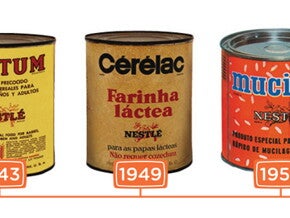
Your baby is entering the Learner Eater stage when she can:
- Sit with support.
- Show good head and neck control.
- Push up with her arms when placed on her stomach.
- Has doubled her birth weight.
In the Learner Eater stage, your baby’s diet is still mainly milk feed (breast milk or infant formula), but milk feed alone can no longer meet her energy needs. Iron reserves are also being depleted.
Your baby is ready to learn about eating when...
- His sucking pattern has changed and he is less likely to drool and spit out food.
- He opens his mouth and leans forward to show that he is hungry, leans back or turns away when he is satisfied.
- His hand-to-mouth co-ordination is good, and he can grasp and move soft food to his mouth.
Until your baby can express these feelings and actions, feeding solids may be a form of force-feeding.
- His sucking pattern has changed and he is less likely to drool and spit out food.
- He opens his mouth and leans forward to show that he is hungry, leans back or turns away when he is satisfied.
- His hand-to-mouth co-ordination is good, and he can grasp and move soft food to his mouth.
Until your baby can express these feelings and actions, feeding solids may be a form of force-feeding.
First steps in giving solids to the Learner Eater
The early tastes (first week) of solid foods are intended more for education than for nutrition. During the first year, milk feed still constitutes the major part of the diet.
The milk feed he drinks will provide almost all the protein, minerals and vitamins that he needs, even when his milk feed intake is reduced because he wants more solid foods. Offer small, baby-sized servings of 1–2 teaspoons at each feed and increase this gradually to portions of 2–4 tablespoons after the milk feed.
Starter solid foods
Avoid strong tastes such as broccoli or cabbage as a starter food. Introduce them at a later stage.
The kind of infant cereal will determine what it should be mixed with: either the current milk feed (Nestlé NESTUM) or previously boiled and cooled water (Nestlé CERELAC). Mix it to a soft, slightly runny consistency. A mixture that is too stiff may make your baby gag. Do not add salt or sugar when preparing strained fruit or vegetables.
Add Nestlé NESTUM to foods such as pumpkin and potato to enhance their nutritional value, throughout the first three years of life.
Introduce one food at a time
The tendency to develop allergies is hereditary. An allergy will generally not manifest itself noticeably on the first occasion that the baby encounters the allergen, it is always wise to start with one new food at a time, over a period of approximately 3–5 days. In this way, you can immediately identify any adverse reactions. Eliminate foods that provoke an allergenic reaction and consult a health professional to ensure the baby’s diet remains nutritionally adequate. This systematic approach generally takes a minimum of one to one-and-a-half months between starting new food groups.
Introduce new foods repeatedly
Never force-feed your baby with solid foods. It is normal for babies to accept new foods only after several attempts. Once your baby is familiar with the food, it may become a ‘favourite’ food; a bitter taste, such as a green vegetable, is such an example. Offer your baby a few teaspoons of vegetables in the same meal as a cereal feed. Once he is used to the veggies, start with fruit. This will establish healthy eating habits from an early age.
Introduce spoonfeeding
Babies often spit out their first semi-solid food rather violently – not because they do not want the food, but because the tongue motion used in sucking is the only motion they know. They must learn an entirely new feeding technique. You will be splattered with the food if their first efforts fail. This could be your first feeding disaster and you may be quite upset. If you laugh at these efforts, your baby may learn to do it to make you laugh. You should prepare yourself to remain undisturbed by these types of feeding incidents.
Healthy, hungry children will eat if they are given a calm atmosphere in which to do so. This is the first and most important consideration. It is unwise to introduce solid foods when you or your baby are overtired – your child probably needs the rest more than the meal.
First spoonfeeding experience
Choose a spoon that is small and smooth-edged. You may find plastic or rubberised spoons easier to use.

Hold a tiny spoon to the baby’s lips and let him suck off the content. He will get enough to taste and, if he likes it, he will go on eating.

Do not put the food on the front of your baby’s tongue, as it will simply dribble out again. He cannot push back far enough to taste or swallow. You will both be frustrated.

Do not put too much food on the spoon or put it too far back in your baby’s mouth. This forces him to swallow with no chance to refuse the food and he may gag.

Do not force him to eat. Let him suck the food from the spoon. Stop feeding if the taste makes him cry or when his closed lips say ‘enough’.
How much should I feed my baby?
Many mothers ask this question, but absolute quantities are not helpful.
- Each baby will eat according to her growth rate. It is important to understand your baby’s behaviour, which will show you when she has had enough.
- She is likely to eat more than she needs, if the food is flavoured with extra sugar, butter or salt.
It is important to know when to start and when to stop feeding. You baby’s behaviour will show you when she is satisfied.

















